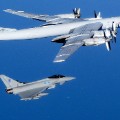Pentagon considered stopping intercepts of Russian aircraft.
The Pentagon considered, and then rejected, the idea of stopping routine intercepts of Russian military aircraft flying off the coast of Alaska, because the U.S. intercept flights appeared to have limited deterrent or intelligence value, according to two U.S. defense officials.While the Russian military flights, usually bomber aircraft, were entering a U.S. "air defense identification zone," they were not entering U.S. airspace, leading to the discussion about whether intercepts should continue, a debate officials routinely have.
The U.S. keeps fighter jets on standby to enter that zone to intercept and monitor the Russian flights, often tracking them, following them, and sometimes taking pictures of them. The U.S. ADIZ generally runs from 12 to 200 miles off the U.S. coastline but is international airspace with freedom of navigation.
Ultimately the Defense Department decided the U.S. intercepts would continue, the officials said. They declined to say when the discussions took place. But "the cost-benefit ratio of doing these missions is always under discussion," one of the officials said. Keeping the flights going as an option "keeps us unpredictable" to the Russians, the official said.
NATO jets scrambled more than 400 times in 2014 for Russian intercepts
The U.S. is continuing the longstanding practice of only intercepting some Russian flights, based on where the Russians are flying. If they remain far off the coastline, the U.S. might not always send up aircraft.
The officials said the U.S. maintains various radars and intelligence sensors that can pick up the Russian flights without necessarily having to deploy aircraft. Several weeks ago the Russians conducted the first flight of the year, but the U.S. chose not to intercept the flight, according to the official.There had been an increase in Russian bombers flights last year, especially in Europe, but the pace of the flights has returned to routine levels this year according to the officials.
News Courtesy: www.cnn.com











